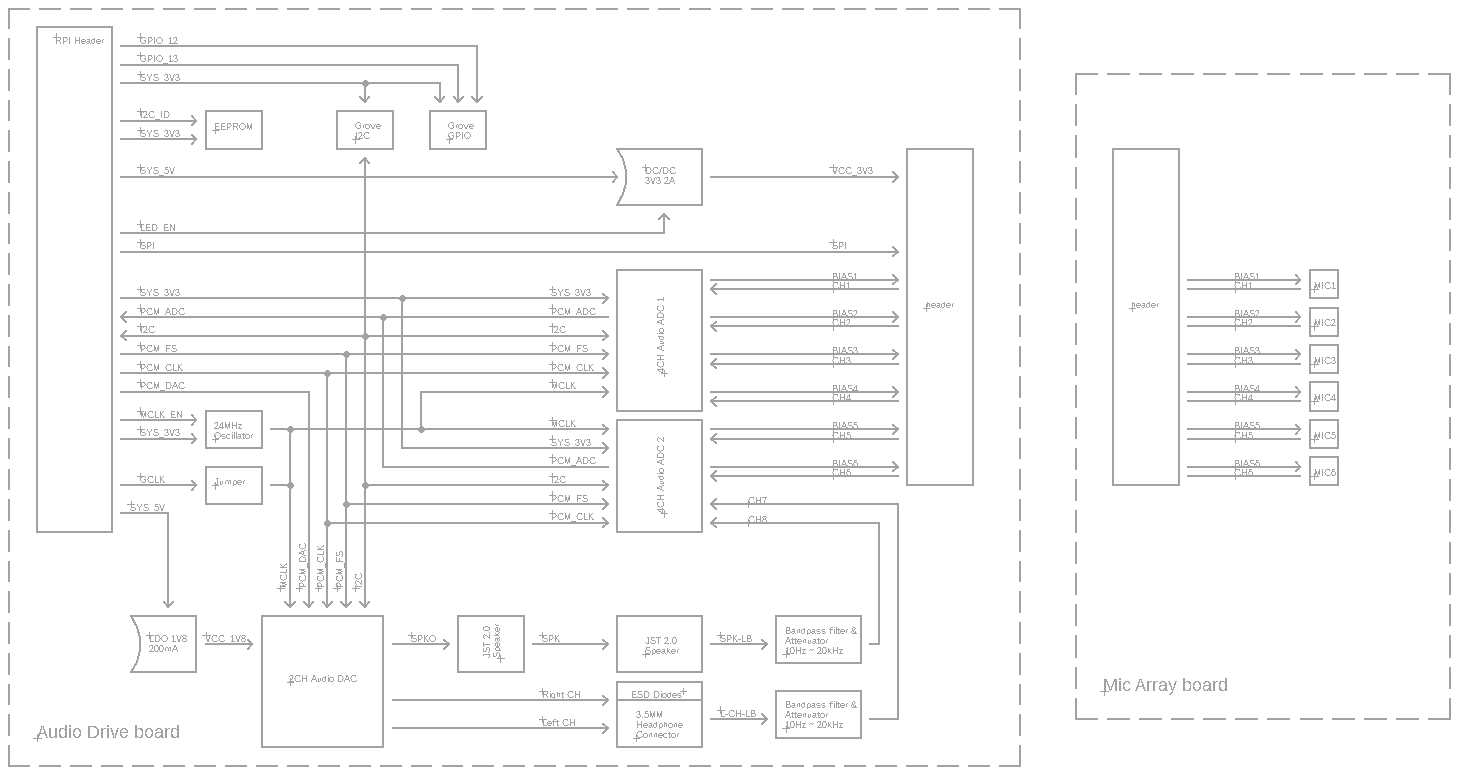ReSpeaker 4-Mic Linear Array Kit

Seeed 的 ReSpeaker 4-Mic Linear Array Kit 是一款为树莓派设计的扩展板,也称为 HAT。这是一个线性麦克风阵列套件,配备四个麦克风,专为 AI 和语音应用而设计。这意味着您可以使用树莓派构建更强大、更灵活的语音产品,可以集成 Amazon Alexa Voice Service、Google Assistant 等。
ReSpeaker 4-Mic Linear Array Kit for Raspberry Pi 由两块板组成,一块是语音配件 HAT,另一块是四麦克风线性阵列。
ReSpeaker 4-Mic Linear Array Kit for Raspberry Pi 在树莓派操作系统中支持 8 个输入和 8 个输出通道。前 6 个输入通道用于麦克风录音(只有前 4 个输入通道是有效的捕获数据),其余 2 个输入通道是播放的回声通道。前 2 个输出通道用于声音输出,其余 6 个输出通道是虚拟通道。
特性
- 2 个 ADC 芯片和 1 个 DAC 芯片
- 8 个输入和 8 个输出通道
- 四麦克风阵列
- Grove 支持
- 树莓派兼容(支持 Raspberry Pi Zero 和 Zero W、Raspberry Pi B+、Raspberry Pi 2 B、Raspberry Pi 3 B、Raspberry Pi 3 B+、Raspberry Pi 3 A+ 和 Raspberry Pi 4)
- 耳机和扬声器语音输出
规格
- 2 x X-Power AC108 ADC
- 4 x 高性能模拟麦克风
- 1 x X-Power AC101 DAC
- 语音输出:
- 3.5mm 耳机音频插孔
- 扬声器插孔
- 兼容树莓派 40 针接头
- 麦克风:MSM321A3729H9BP
- 灵敏度:-22 dBFS(全向)
- 信噪比:59 dB
- 最大采样率:48Khz
应用创意
- 智能音箱
- 智能语音助手系统
- 语音录音机
- 语音会议系统
- 会议通信设备
- 语音交互机器人
- 车载语音助手
- 其他需要语音命令的场景
硬件概述
系统图

接口

连接后,请务必使用万用表确定电路的导通是否如上图所示。
装配图

入门指南
将 ReSpeaker 4-Mic Array 连接到 Raspberry Pi
步骤 1. 通过排线将 ReSpeaker Voice Accessory HAT 与 ReSpeaker 4-Mic linear Array 连接
步骤 2. 通过 40 针 GPIO 将 ReSpeaker Voice Accessory HAT 插入 Raspberry Pi
步骤 3. 将 耳机 插入 3.5mm 耳机音频插孔 或将 扬声器 插入 JST 2.0 扬声器插孔
步骤 4. 通过 micro-USB 线缆将 Raspberry Pi 与 PC 连接

软件
步骤 1. 安装 seeed-voicecard
获取 seeed voice card 源代码,并安装所有 linux 内核驱动程序。
sudo apt-get update
git clone https://github.com/HinTak/seeed-voicecard.git
cd seeed-voicecard
sudo ./install.sh
sudo reboot
步骤 2. 检查声卡
点击下方的命令来检查录音设备。
pi@raspberrypi:~ $ arecord -L
It should be like:
pi@raspberrypi:~ $ arecord -L
null
Discard all samples (playback) or generate zero samples (capture)
default
Playback/recording through the PulseAudio sound server
ac108
dmixer
ac101
sysdefault:CARD=seeed8micvoicec
seeed-8mic-voicecard,
Default Audio Device
dmix:CARD=seeed8micvoicec,DEV=0
seeed-8mic-voicecard,
Direct sample mixing device
dsnoop:CARD=seeed8micvoicec,DEV=0
seeed-8mic-voicecard,
Direct sample snooping device
hw:CARD=seeed8micvoicec,DEV=0
seeed-8mic-voicecard,
Direct hardware device without any conversions
plughw:CARD=seeed8micvoicec,DEV=0
seeed-8mic-voicecard,
Hardware device with all software conversions
使用以下命令检查播放设备。
pi@raspberrypi:~ $ aplay -L
It should be like:
pi@raspberrypi:~ $ aplay -L
null
Discard all samples (playback) or generate zero samples (capture)
default
Playback/recording through the PulseAudio sound server
ac108
dmixer
ac101
sysdefault:CARD=ALSA
bcm2835 ALSA, bcm2835 ALSA
Default Audio Device
dmix:CARD=ALSA,DEV=0
bcm2835 ALSA, bcm2835 ALSA
Direct sample mixing device
dmix:CARD=ALSA,DEV=1
bcm2835 ALSA, bcm2835 IEC958/HDMI
Direct sample mixing device
dsnoop:CARD=ALSA,DEV=0
bcm2835 ALSA, bcm2835 ALSA
Direct sample snooping device
dsnoop:CARD=ALSA,DEV=1
bcm2835 ALSA, bcm2835 IEC958/HDMI
Direct sample snooping device
hw:CARD=ALSA,DEV=0
bcm2835 ALSA, bcm2835 ALSA
Direct hardware device without any conversions
hw:CARD=ALSA,DEV=1
bcm2835 ALSA, bcm2835 IEC958/HDMI
Direct hardware device without any conversions
plughw:CARD=ALSA,DEV=0
bcm2835 ALSA, bcm2835 ALSA
Hardware device with all software conversions
plughw:CARD=ALSA,DEV=1
bcm2835 ALSA, bcm2835 IEC958/HDMI
Hardware device with all software conversions
sysdefault:CARD=seeed8micvoicec
seeed-8mic-voicecard,
Default Audio Device
dmix:CARD=seeed8micvoicec,DEV=0
seeed-8mic-voicecard,
Direct sample mixing device
dsnoop:CARD=seeed8micvoicec,DEV=0
seeed-8mic-voicecard,
Direct sample snooping device
hw:CARD=seeed8micvoicec,DEV=0
seeed-8mic-voicecard,
Direct hardware device without any conversions
plughw:CARD=seeed8micvoicec,DEV=0
seeed-8mic-voicecard,
Hardware device with all software conversions
步骤 3. 录制并播放
你可以先录制然后播放,或者可以同时录制和播放。
#It will capture sound on AC108 and save as a.wav
arecord -Dac108 -f S32_LE -r 16000 -c 8 a.wav
#Take care of that the captured mic audio is on the first 6 channels
#It will play sound file a.wav on AC101
aplay -D ac101 a.wav
#Do not use -D plughw:1,0 directly except your wave file is single channel only.
使用4麦克风线性阵列套件同时进行录制和播放的开发者限制:
-1. 必须先开始录制,否则录制通道可能会出现混乱。
-2. 播放输出通道必须填充8个相同通道数据或4个相同立体声通道数据,否则扬声器或耳机可能无法输出任何声音。
-3. 如果您想同时播放和录制,aplay音乐文件必须是单声道,否则您无法使用此命令进行播放。
您也可以使用Audacity进行播放和录制。
您应该通过VNC打开Audacity,或者您可以直接使用显示器打开它
sudo apt update
sudo apt install audacity
audacity // run audacity

使用概述
要运行以下示例,请将 4mics_hat 仓库 克隆到您的树莓派上
git clone https://github.com/respeaker/4mics_hat.git
下面示例中提到的所有 Python 脚本都可以在此仓库中找到。要安装必要的依赖项,请从 mic_hat 仓库文件夹运行
sudo apt-get install portaudio19-dev libatlas-base-dev
pip3 install -r requirements.txt
使用 Python 录制声音
我们使用 PyAudio python 库 来通过 Python 录制声音。
首先,运行以下脚本来获取 2 Mic pi hat 的设备索引号:
python3 recording_examples/get_device_index.py
您将看到如下所示的设备 ID。
Input Device id 2 - seeed-8mic-voicecard: - (hw:1,0)
要录制声音,请使用 nano 或其他文本编辑器打开 recording_examples/record.py 文件,并将 RESPEAKER_INDEX = 2 更改为您系统上 ReSpeaker 的索引号。然后运行 python 脚本 record.py 进行录制:
python3 recording_examples/record.py
- 步骤 6. 如果您想从 8 个通道中提取通道 0 的数据,请查看
record_one_channel.py的内容。对于其他通道 X,请将 [0::8] 更改为 [X::8]。
python3 recording_examples/record_one_channel.py
要播放录制的样本,您可以使用 aplay 系统实用程序,例如
aplay -f cd -Dhw:0 output.wav #for Stereo sound
aplay -D plughw:0,0 output_one_channel.wav #for Mono sound from one channel
常见问题
Q1: 麦克风阵列中只有4个麦克风,怎么会是8通道?
A1: 这个阵列中有2个AC108,每个AC108芯片有4个通道输出。所以总共有8个通道,其中4个用于麦克风,2个通道用于播放,其余2个通道未使用。
Q2: 如果树莓派可以检测到ReSpeaker 2-mics hat,但无法检测到ReSpeaker 4-mics线性阵列?
A2: 请点击树莓派 -> 首选项 -> 树莓派配置,然后选择接口选项卡,确保1-Wire是禁用状态。
资源
- [PDF] AC101 数据手册
- [PDF] AC108 数据手册
- [驱动] Seeed-Voice 驱动
- [算法] 包含DOA、VAD、NS的算法
- [语音引擎] 语音引擎项目,提供构建语音功能对象的构建块
- [算法] AEC
- [机械图纸] 2D图纸
项目
魔镜魔镜 - 带有ReSpeaker的智能镜子!:一个通过ReSpeaker进行语音界面控制的智能镜子。我们还连接了Wio Link来控制其他对象!基于树莓派。
技术支持与产品讨论
感谢您选择我们的产品!我们在这里为您提供不同的支持,以确保您使用我们产品的体验尽可能顺畅。我们提供多种沟通渠道,以满足不同的偏好和需求。
